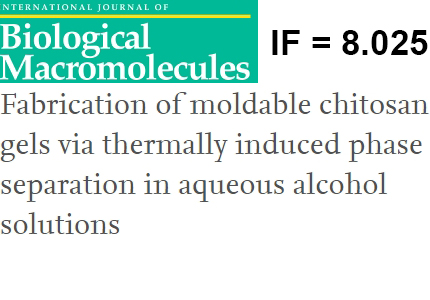Press-room / Digest

Fabrication of moldable chitosan gels via thermally induced phase separation in aqueous alcohol solutions
A team of scientists from the Laboratory of polymers for biology IBCh RAS has developed an original formation method of transparent thermoreversible chitosan alcogels with controlled mechanical strength by cooling chitosan/H2O/ethanol ternary systems down to temperatures higher than their freezing points. Non-swelling (at pH ≥ 5,5) structures of complex shape were produced by processing preformed alcogels with base solutions. In collaboration with colleagues from FSRC “Crystallography and photonics” RAS we demonstrated nanofibrous structure of the produced gels and revealed that the developed method can be easily applied for such techniques as pressure casting and 3D printing. The results of in vitro and in vivo experiments showed lack of pronounced cytotoxicity and demonstrated biocompatibility with living tissues. The work was published in the International Journal of Biological Macromolecules.

Synthesis of New 5ʹ-Norcarbocyclic Aza/Deaza Purine Fleximers - Noncompetitive Inhibitors of E.coli Purine Nucleoside Phosphorylase
Scientists from the Laboratory of biosynthesis of physiologically active compounds and Laboratory of biopharmaceutical technologies (IBCH RAS) and EIMB RAS synthesized a new series of flexible 5′-norcarbocyclic aza/deaza-purine nucleoside analogs and evaluated as potential inhibitors of E. coli purine nucleoside phosphorylase. The synthesized compounds were evaluated as potential inhibitors of E. coli purine nucleoside phosphorylase. Three analogs were found to be noncompetitive inhibitors with inhibition constants of 14–24mM. From the data obtained, it can be assumed that the new 5′-norcarbocyclic nucleoside analogs interact with the active site of the PNP like natural heterocyclic bases. But at the same time the presence of a cyclopentyl moiety with 2′ and 3′ hydroxyls is necessary for the inhibitory properties, since compounds without those groups did not exhibit an inhibitory effect under the experimental conditions. The results are published in the Frontiers in Chemistry. Learn more

Positively charged black hole quencher (BHQ) derivatives as external SERS active responsive elements of biosensors
Scientists from the Group of molecular tools for living system studies (IBCh RAS), Department of chemistry of Natural Compounds (Faculty of Chemistry, MSU) and Osipyan Institute of Solid State Physics, together with the Laboratory of Molecular Design and Synthesis (IBCh RAS), have developed external SERS-active responsive elements based on positively charged black hole quencher (BHQ) derivatives. The proposed derivatives as external responsive elements can increase sensitivity, simplify biosensors and reduce their cost, as well as speed up the process of quantitative and qualitative analyte determination. The study results are published in Analytica Chimica Acta (IF 6.911) and Frontiers in chemistry (IF 5.545). Learn more

Streptocinnamides A and B, Depsipeptides from Streptomyces sp. KMM 9044
A new structural group of antibiotics produced by a new strain Streptomyces sp. KMM 9044 was discovered as a result of teamwork of scientists from the Institute of Bioorganic Chemistry (IBCh RAS) and the Elyakov Pacific Institute of Bioorganic Chemistry (TIBOCh RAS). During the cultivation of the strain in the marine environment, two compounds with antibacterial activity were isolated. The structure of these compounds was established using the NMR and HRMS methods and also confirmed by a series of chemical transformations. The family of new compounds are chlorinated cyclic depsiheptapeptides containing 3-hydroxy-4-chlorvaline and 4-acetoxy-5-methylproline, non-standard amino acids in the depsipeptide macrocyclic structure and a glyceric acid residue. An interesting property of these antibiotics is the strong selective inhibition of a number of Gram-positive bacteria: Micrococcus sp., Arthrobacter sp., and Mycobacterium smegmatis. The results are published in Organic Letters. Learn more

Lignans as Pharmacological Agents in Disorders Related to Oxidative Stress and Inflammation: Chemical Synthesis Approaches and Biological Activities
Plant lignans are active components of many herbs, which makes them the research objects for therapeutic agents development for practical use. They provide diverse naturally-occurring pharmacophores, which allows them to interact with various enzymes, receptors, ion channels and signaling molecules. A team of scientists from IBCh RAS published a review that summarizes the comprehensive knowledge about lignan use as a bioactive compounds in disorders associated with oxidative stress and inflammation, pharmacological effects in vitro and in vivo, molecular mechanisms underlying these effects, and chemical synthesis approaches. The work is published in the International Journal of Molecular Sciences. Learn more

